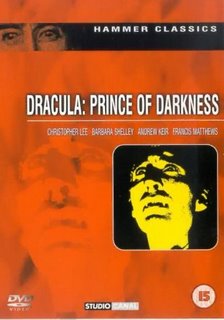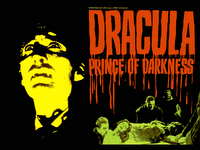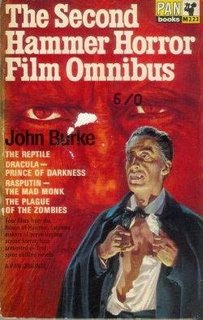
Director: Terence Fisher
Release Date: 1966
Contains Spoilers
If Brides of Dracula (1960) was the Van Helsing character’s sequel to Horror of Dracula (1958), then this most certainly is the Dracula character’s sequel. In fact the film shows the death sequence from the ’58 film at the beginning of this movie. This is followed by a scene in which we see a funeral line going into the woods with the body of a young woman, fully intent on staking her despite her mother’s protests. The desecration is stopped by a grizzly bear of a monk, Father Sandor (Andrew Keir), who travels with a gun and, we discover later, likes to shoot deer and keep his posterior warm.
In an inn are four English tourists, adventurous Charles Kent (Francis Matthews) who is drinking a yard of ale and buying rounds of drinks for the locals, his wife Diana (Suzan Farmer), his brother Alan (Charles Tingwell) and Alan’s shrewish wife Helen (Barbara Shelly). Just before they retire to bed Sandor enters. He admonishes the locals for hanging garlic, saying that 'it' was over 10 years ago – which puts the film in context time wise. On talking to the tourists he tries to get them to go to his monastery for a visit, but warns them about their intended destination, Carlsbad, and more firmly warns them away from the castle. A castle that does not appear on the maps.
The next day the two couples are abandoned 2km from Carlsbad as their coach driver will go no further; he refuses to acknowledge the castle nearby but says he will return 2 hours after dawn the next day. Helen, who so far has done nothing but complain, begins to feel uneasy. They agree to stay in a nearby woodcutter’s hut when a coach appears, with no driver. Charles stops it and suggests they take it to Carlsbad. When they set off, however, the horses have other ideas and head for the castle, not responding to Charles’ commands and stopping right outside the castle door. They alight and the coach charges off. Helen is still predicting doom and gloom but they enter and find the dinner table set for four. Further investigation by the men reveals that their belongings (thought lost on the runaway coach) are in rooms - the investigation ends when Helen screams. They race downstairs but discover she has been frightened by the appearance of Klove (Philip Latham), the butler. He explains that his master, who is dead, instructed that the castle always be ready to accept visitors. Perhaps things would have been different for the travellers if they had taken Helen’s sense of doom seriously, “There’ll be no morning for us.” Or maybe they should have been worried when Charles toasts their dead host Dracula with “May he rest in peace” and all the candles begin to flicker. Of course, if they were that sensible they’d never had ended up at the castle anyway!
Helen awakens in the night believing someone called her name and footsteps, plus dragging, can be heard. Alan goes to investigate and, eventually, is stabbed by Klove for his trouble. In a spectacular resurrection scene, Alan is suspended above Dracula’s coffin, into which Klove pours Dracula’s ashes and then slits Alan’s throat. Helen is lured out to meet her husband and instead sees Alan suspended and meets Dracula. A word here about Lee’s performance. Seemingly he found his scripted dialogue so bad that he arranged for himself to play the role mute. There are gestures and hisses, but no words. That said, the man’s presence fills the screen whenever he is there.
In the morning the castle seems deserted and Alan and Helen have  apparently gone. Eventually Charles takes Diana back down to the road and then returns to investigate further. Unfortunately Diana is picked up by Klove and returned to the castle. The previously shrewish Helen has now developed a taste for diaphanous nightgowns plus a voluptuous cleavage and a set of fangs. She tries to bite Diana but is stopped by Dracula who clearly wants her for himself. Charles enters the fray and a fight ensues which is ended when Diana’s crucifix burns Helen. Charles is quick on the uptake and uses the two parts of a broken sword to make a makeshift cross and they manage to escape in Klove’s buggy. Unfortunately it crashes, Charles struggles through the woods with Diana until found by Sandor.
apparently gone. Eventually Charles takes Diana back down to the road and then returns to investigate further. Unfortunately Diana is picked up by Klove and returned to the castle. The previously shrewish Helen has now developed a taste for diaphanous nightgowns plus a voluptuous cleavage and a set of fangs. She tries to bite Diana but is stopped by Dracula who clearly wants her for himself. Charles enters the fray and a fight ensues which is ended when Diana’s crucifix burns Helen. Charles is quick on the uptake and uses the two parts of a broken sword to make a makeshift cross and they manage to escape in Klove’s buggy. Unfortunately it crashes, Charles struggles through the woods with Diana until found by Sandor.
Hammer have again changed the rules, ever so slightly, and it is Sandor who explains this. It is added into the mythology that running water drowns vampires. They also add that they must be invited over a threshold but if they are then such things as garlic have no deterrent effects. Having been cheated of Diana, Sandor believes that Dracula will think she belongs to him and hunt her down. Indeed Dracula has come to the monastery. There are actually a few elements from here that are straight out of Stoker's book. There is a man, Ludwig (Thorley Walters), living in the monastery who was found near castle Dracula 12 years before. He eats bugs and is obviously a Renfield character and facilitates Dracula’s entry into the monastery.
When in there, as the monks and Charles take care of a snarling Helen by means of a stake, Dracula tries to force Diana to drink from his chest, though he is disturbed and it does not happen. Again this is book reminiscent.
The concept of vampires being killed by drowning owes a little to the book (and certainly other vampire myths). In the book Dracula cannot cross running water of his own volition and in books such as Carmilla running water is used to dispose of vampires, or their remains at least. Drowning does seem a stretch as, being dead, they don’t need to breath… but we’ll let that go.
Finally, when Klove races back to Castle Dracula, chased by Sandor and Charles on horseback, I was reminded of the chase through the Carpathians from the book. Klove, incidentally, is shot.
One question raised by their escape was how Dracula got into his coffin. Sandor and Charles had placed crucifixes in his and Helen’s. Obviously Klove removed the offensive items, but this is not actually shown or alluded to.
In a scene reminiscent of the earlier Brides of Dracula (1960) , Sandor shows that the contagion of vampirism can, if treated early enough, be burnt out. When Helen manages to bite Diana’s wrist, Sandor burns the wound with a hot lamp, stating that he did it just in time.
The demise of Dracula is based around the new rule Hammer introduced. Dracula’s coffin is spilled from the wagon onto ice and Charles crosses it to stake him. I have read criticism of the apparent rapid season shift from summer in the woods to winter around the castle, but I didn’t see it as a problem. All through the film it is icy around the castle, though not in the woods, and I assumed, simply, that the castle was at a higher altitude. The sun sets and Dracula bursts from his coffin, attacking Charles. Diana takes Sandor’s gun, shoots and misses, the shot cracking the ice. Sandor, taking his gun back, fires repeatedly causing the ice to break around the Count and then tip, so that Dracula falls into the water and drowns. A small .mov clip of Dracula’s death can be found here.
The film is a great watch and this is, in my opinion, down to three performances. Lee, whose presence, as I mentioned earlier, is all encompassing. That said his on screen time is low, in fact he isn’t even resurrected until the film has gone more than half way through its running time. Keir is fantastic as Sandor; he is kindly, yet gruff and really comes across as the sort of guy you want by your side in a fight.  To me, though, Barbara Shelley’s portrayal of Helen is a key factor in the success of this movie. She is thoroughly detestable at first and yet the palpable tension, which the viewer can feel when the couples spend the night in the castle, is created largely through her acting (even if her screams were dubbed by Susan Farmer). She seems truly terrified and Fisher uses this by cutting to her reactions as Alan searches the castle. Once she is turned she is seductive and when caught and destined for staking her hisses are animalistic and disturbing. This is a great Hammer Dracula and I’ll give it 7 out of 10.
To me, though, Barbara Shelley’s portrayal of Helen is a key factor in the success of this movie. She is thoroughly detestable at first and yet the palpable tension, which the viewer can feel when the couples spend the night in the castle, is created largely through her acting (even if her screams were dubbed by Susan Farmer). She seems truly terrified and Fisher uses this by cutting to her reactions as Alan searches the castle. Once she is turned she is seductive and when caught and destined for staking her hisses are animalistic and disturbing. This is a great Hammer Dracula and I’ll give it 7 out of 10.
For a further review check Exclamation Mark's Vintage SciFi/Horror Review.
The imdb page is here.
Bonus Mini Review
 The Second Hammer Film Omnibus
The Second Hammer Film Omnibus
Author: John Burke
This is a book containing four Hammer novelisations, The Reptile, Dracula: Prince of Darkness, Rasputin the Mad Monk and The Plague of Zombies. The Dracula piece is fairly short at some 85 pages long.
In the main it follows the film, though it deviates slightly in the order of events and a couple of the names change. It is clear that the travellers in the film are heading to Carlsbad, we even see a signpost to that effect, in the book it is suddenly Josefsbad. In the credits of the movie Keir’s character is definitely named Sandor but in the book he becomes Shandor. It must be stated that, when reviewing the film, I mentioned that Charles is quick on the uptake when he makes a cross from a broken sword, not so in the written version where Diana has to spell it out for him. ‘“A Cross!” Diana cried. “Charles – Make a cross!”’ In this respect the book probably captures the essence of the character much better than the actual film did, given that Charles did come across as a bit thick!
These are minor differences however; the question is more was the book worthwhile? I’ve owned this for years; in fact until recently I forgot I had it. (As an aside, my edition has Rasputin as the cover rather than Dracula.) As a kid I can remember being thoroughly taken with it. Re-reading it as an adult, with an interest in the vampire genre specifically and Hammer films generally I found it to be an interesting curio. The prose itself is functional and I’ll give the book 5 out of 10.
Monday, May 29, 2006
Dracula, Prince of Darkness - review
Subscribe to:
Post Comments (Atom)
















2 comments:
This is the first Hammer Dracula I watched when I was like 6 years old and it still stays in my heart as one of my favorites, though I prefer Horror of Dracula. From the first time I saw his performance here, I just knew Christopher Lee was Dracula.
It's a pity that with each successive Hammer Dracula, Lee was given less screen time, and less movement! (Starting in the next one he's almost restricted to one room per movie!) Yet even in that situation he runs circles around all other Draculas..
I love the final scene. It's original and well-done (for that year's standards).
Hammer films are the stuff of legend really...
Can't disagree... truly the stuff of legend.
Post a Comment